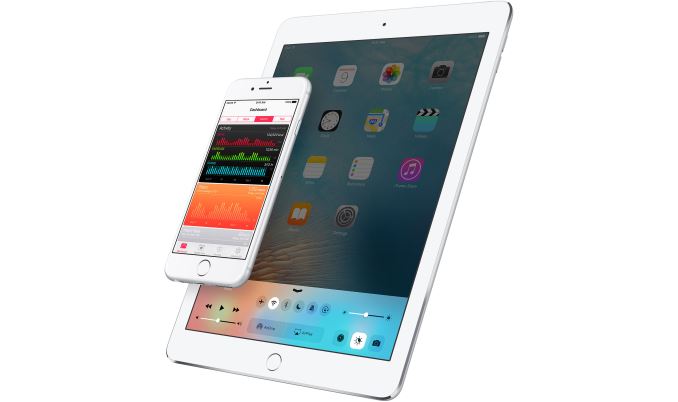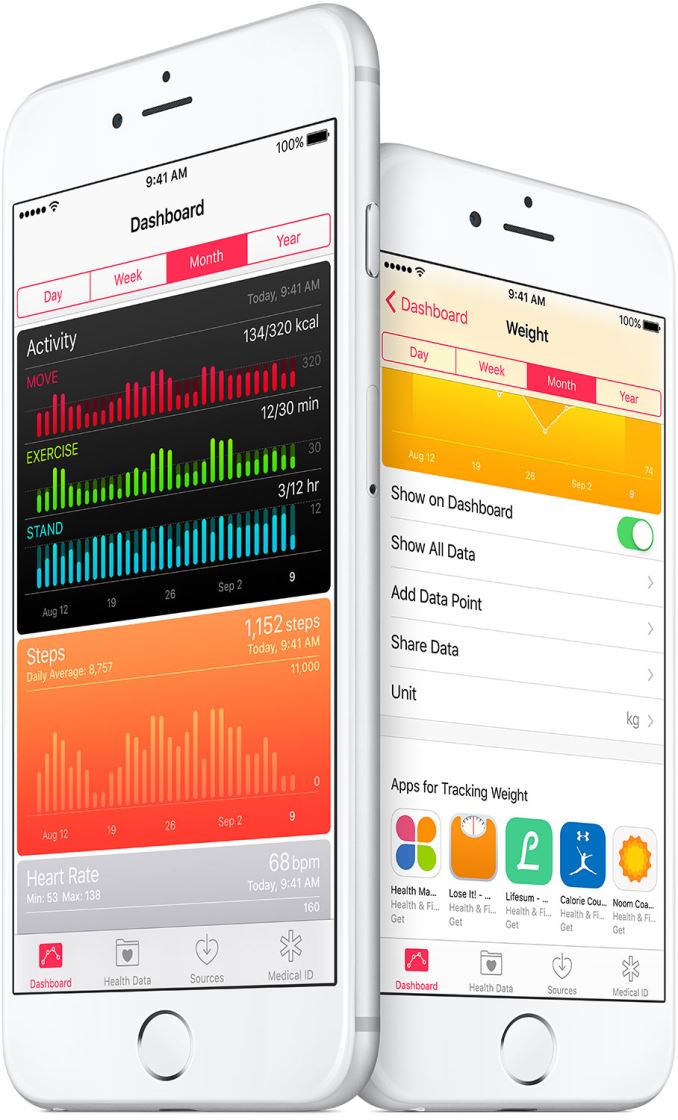Apple Releases iOS 9.3
by Brandon Chester on March 21, 2016 2:55 PM EST- Posted in
- Smartphones
- Apple
- iOS
- Tablets

Along with the iPhone SE and 9.7" iPad Pro, today's Apple event came with an official release of iOS 9.3. iOS 9.3 has been in beta for quite some time now, with there being both a developer and a consumer beta stream. While 9.3 isn't a major point release, it is significantly larger than most of the minor iOS updates that are released, with there being both new features and bug fixes included.
For many users the most significant feature in iOS 9.3 is Night Shift. For anyone who uses or has has heard of f.lux, Night Shift is basically Apple's version of the same thing for iOS. It alters the white balance of your display to reduce the blue component of luminance. There have been various studies on the negative effects of exposure to blue shifted lighting on a person's ability to sleep, and with iOS devices generally having slightly blue shifted white points this can pose a genuine issue for users reading on their iPhone or iPad before going to bed.
Night Shift has a few options. You can forcibly enable or disable it from the settings app or from Control Center, and you can also set it to enable on a schedule. There's also a slider that controls how far the white point is shifted toward red, with the warmest setting being about as far as you can go without disrupting usability.
Another notable iOS 9.3 feature is support for Touch ID in the Notes application. With the Notes app seeing more use and potentially storing more sensitive data after the release of the iPad Pro, being able to protect the content inside using Touch ID is a useful feature to have.
The Health app sees some changes as well. It now integrates deeper with the Activity application that gathers data from the Apple Watch, and includes a new dashboard pane that summarizes your exercise info from the Activity app. Previously the Health app would simply pull information from the Activity app and populate its own data sections, and better integration of the two apps is probably overdue. Apple has also added sliders in certain sections that can reveal featured apps that integrate and aggregate data in the Health app.
For iPhone 6s and 6s Plus users, iOS 9.3 adds 3D Touch support from the home screen for a few additional applications, including Weather, App Store, Health, Compass, Settings, and Stocks. 3D Touch support for Weather is a nice addition, and I was surprised by the omission when the 6s first launched.
iOS 9.3 will be coming to compatible iOS devices today. It will be supported on all devices that support iOS 9, which includes all iPads from the iPad 2 onward, and all iPhones from the iPhone 4s onward.











11 Comments
View All Comments
zeeBomb - Monday, March 21, 2016 - link
I had many of these features in CyanogenMod already teeheeJoeyJoJo123 - Monday, March 21, 2016 - link
I have never understood why someone would use f.lux and its alternatives. If your eyes are hurting looking at a screen you should do one of the following things first before ever considering using f.lux or an alternative:1) See an eyedoctor and update your prescription glasses/contacts.
2) Turn off the screen and do something else for a break. Focusing on a point in space that's near (monitor, book, etc) causes more strain for muscles that control optical focus than a point far in the distance.
3) Turn down the brightness of the monitor. 120 cd/m is standard for critical viewing applications. It's a _lot_ lower than the standard 300 cd/m many screens today are sold as.
4) Purchase a colorimeter for your device and properly balance the colors around a comfortable white point. Many screens using LEDs have a native bluish white, and proper calibration not only shows the colors the way they are meant to be shown, but can also correct blue-tinted screens.
5) Purchase a monitor that has a higher refresh rate. It's a bit harder to focus on jittery motion than fluid motion. Higher refresh rates can somewhat alleviate eye-strain in applications where you're viewing fast-paced content for long periods of time (ex: games).
6) If you're having trouble sleeping, turn off the screen (or significantly dim the screen) before going to sleep. This sometimes can't be helped though.
NOTE:
Using SOFTWARE to stain your display yellow is NOT a solution for OCULAR STRAIN or assisting your sleep at night.
The so-called benefits of f.lux and its are dumbfounded and are not entirely accurate.
jann5s - Monday, March 21, 2016 - link
I'm sorry mate, I'm not convinced, I use f.lux and I like it.JoeyJoJo123 - Monday, March 21, 2016 - link
Just consider for a second that the problem (ocular strain) is a physical phenomena internal to your body, and that you're using "software" to fix that. Your body isn't 1's and 0's, so its inherent benefit is ultimately limited to masking/hiding the issue, rather than providing a solution.Secondly, consider the possibility 10 years ago (years before you ever heard of f.lux) where adopters of 1st gen LCD sets had aging TVs that had significant yellow cast to the entire image. Families didn't keep these TV sets in their house "because it's easier on the eyes". They threw them out in favor of the shiny new LCDs at Wal-mart "because the football games looked better".
You've mentally already associated a yellow hue in your mind as a "good thing" because others have told you "it's good for your eyes". It's a placebo you've bought into.
That being said, placebos can work in terms of making people "feel" comfort. And to each his own if they want to swallow that placebo pill in the morning.
I remain incredibly skeptical and have found much more significant comfort by properly tuning my displays to what is comfortable to my specific eyes rather than keeping the high-contrast high-brightness store display settings of the display and trying to haphazardly "fix" it using, again, global settings on f.lux, rather than tuning the device for your eyes.
Murloc - Monday, March 21, 2016 - link
Joey you're mixing up issues.The f.lux fixes the issue that blue light has a spectrum more similar to the day sky, and thus induces the production of hormones that keep you awake, or viceversa it stops the production of the going-to-sleep hormones.
If you remove the blue light, it's better. Even better is not using smartphones shortly before or in bed at all, it's a bad habit.
The reverse idea is using blue lights in the morning to help people with seasonal affective disorder.
Not having too much brightness also helps simply by virtue of having less light in the eyes but most phones can already adapt brightness to ambient light so it's nothing new.
JoeyJoJo123 - Monday, March 21, 2016 - link
I see what you're doing:You're dodging the issue of ocular strain and trying to change the issue here to talk exclusively about hormones relating to sleep/waking hours. People DO buy into the yellow hue to avoid ocular strain/discomfort during prolonged screen viewing time. Gunnar's glasses are predominantly marketed towards gamers who game for long periods of time and experience ocular discomfort. We'll return to this in a moment.
To answer your discussion on hormones:
98.6 degrees is the average human body temperature, but you don't know someone's body temperature until you measure. People are all different and will perceive things differently, even placebos may be "effective" to some and not to others.
Let's tie this back to ocular properties of people. Everyone has different vision. People are measured for their eyesight at an eyedoctor and are given prescription eyewear for their specific eyes. This eyewear is best suited to that individual, but not to anyone else. A single universal pair of glasses is not effective for all people.
Let's tie this back around to hormone production for sleep/waking cycles. You claim that f.lux can aid people's hormone production for healthier sleeping/waking hours. While scientific studies have shown the differences in hormone production for an average person to differ between blue and yellow light, for example, have several scientific studies been performed for people using f.lux (or alternatives) under a controlled environment and then measured for the difference in hormone production?
And even more importantly, have you tuned the amount of yellow casting f.lux uses by measuring your hormone production to optimally affect your sleep/waking hours? No. You haven't.
What you're essentially suggesting is using the software equivalent of a generic pair of reading glasses (which isn't a solution for poor eyesight. read: not a panacea or magical elixir for poor eyesight) to correct hormone production during sleeping/waking times, where hormone production levels vary from person to person.
Therefore, because the general software user cannot measure their sleep/waking hormone production before/after the use of f.lux, f.lux is ultimately no more effective at resolving a poor sleep schedule than a pair of generic reading glasses are for curing poor eyesight. f.lux is not a panacea. It's not a magical elixir. It does not affect all people the same and its specific effects have not ultimately been measured for you, either.
What is a valid solution is having your eyes measured and getting prescription eye-wear.
What is a valid solution is measuring your display's brightness and tuning that down.
What is a valid solution is measuring your display's whitepoint and tuning that according to the room or environment you'll be viewing that display in.
f.lux is not a solution.
And before you continue, please do answer my previous post in full about ocular discomfort in full before trying to change the topic to something else entirely.
Maltz - Monday, March 21, 2016 - link
Joey, no one is talking about ocular strain but you. f.lux makes no claims about it (to my knowledge) and neither does Night Shift. These products are *strictly* for the color temperature / hormone production effects. He's not dodging the strain issue - you're injecting it into a topic that has nothing to do with it.As for how medically sound any of this stuff is, well, I'm sure it hasn't passed FDA rigor as a medical device, if that's what you're expecting of it. But SOME people think it helps them. Does it? Maybe. Maybe because it helps their hormone levels, or maybe it's the placebo effect, but either way, changing a device's color temperature does zero harm, and if people are getting better sleep (something which is very important to health, according to many, many clinical studies) who are you to give them a hard time about it?
doggface - Tuesday, March 22, 2016 - link
The purpose of F.lux is to encourage the production of melatonin at night. Nothing to do with ocular discomfort. Everything to do with well documented effects of white light in keeping you awake when u should be asleep.thefivetheory - Thursday, March 24, 2016 - link
Wow.Intervenator - Thursday, March 24, 2016 - link
...Thought I was looking at the WCCF comment section for a second.